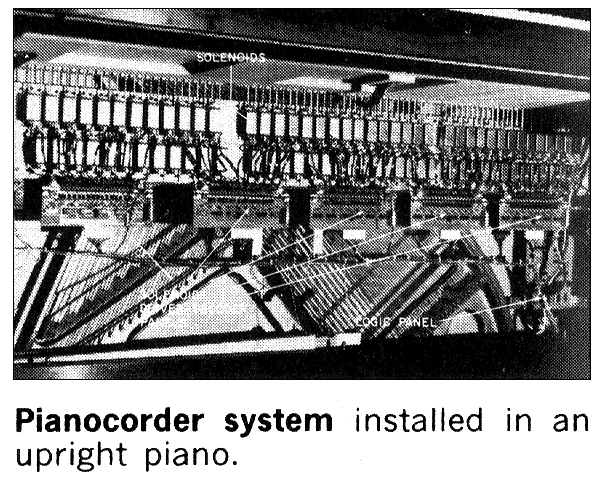| You Are Not Logged In | Login/Get New Account |
|
Please Log In. Accounts are free!
Logged In users are granted additional features including a more current version of the Archives and a simplified process for submitting articles. |
|
MMD
 Pictures
Pictures
 pianocorder
pianocorder
|
|
article in Electronic Design magazine, July 19, 1977, page 21 courtesy Mike Knudsen (000315 MMDigest)
The first electronic player piano replaces the familiar piano rolls with magnetic tape recorded with digital data. The Pianocorder selects the grouping and sequence in which the keys are played by decoding the data, and also controls how hard solenoids are actuated to drive the string hammers. Standard Philips magnetic-tape cassettes can be used both to play recorded songs and to record, for example, a student's piano lesson, and play it back. Developed by Superscope, Chatsworth, CA, the basic Pianocorder system will come either as a kit to be installed on any upright or spinet piano, or as a "Vorsetzer" unit that can be rolled up to a piano keyboard. Padded fingers extend from the latter unit to press the keys. To minimize drop-outs and ensure maximum data reliability in either the playback or recording mode, the cassette runs at 3-3/4 in. per second -- twice the normal speed -- and at bit rates greater than 4-kbits/s. To make original studio recordings, an 8080 uP-controlled system samples each key as it is depressed. Separate transducers on each key monitor key displacement, actuation speed and the pressure on each struck key. This parallel information is then digitized and multiplexed into serial format. In playback, a logic panel delivers this information to five driver-decoder PC panels via a bus system. The Pianocorder system records and monitors 32 levels of intensity with which a key is hit, and decodes this information to drive the solenoids with a variable pulse width at full voltage. The wider the pulse the louder the struck note sounds. To record on the home system, the sound intensity can be monitored by a microphone. The sound level from the microphone is applied to an arithmetic circuit that samples, at any instant, the sound volume, and the number of keys depressed. This sampling is converted, using an algorithm, into various sounds that mimic those of the original piece. Volume production of the Pianocorder is slated to begin next January. The kit is expected to retail between $1250 and $1500, while the Vorsetzer unit is expected to sell for $1500 to $2000. With either the Pianocorder or Vorsetzer units, a prerecorded library of 100 45-minute cassettes will be furnished, many of them containing recordings of piano-roll classics from a 15,000-roll collection of Joseph S. Tushinsky, Superscope's president.
15 March 2000 |
|
|
|
|
|
|
|
|
|
CONTACT FORM: Click HERE to write to the editor, or to post a message about Mechanical Musical Instruments to the MMD Unless otherwise noted, all opinions are those of the individual authors and may not represent those of the editors. Compilation copyright 1995-2026 by Jody Kravitz. Please read our Republication Policy before copying information from or creating links to this web site. Click HERE to contact the webmaster regarding problems with the website. |
|
|
||||||
|
